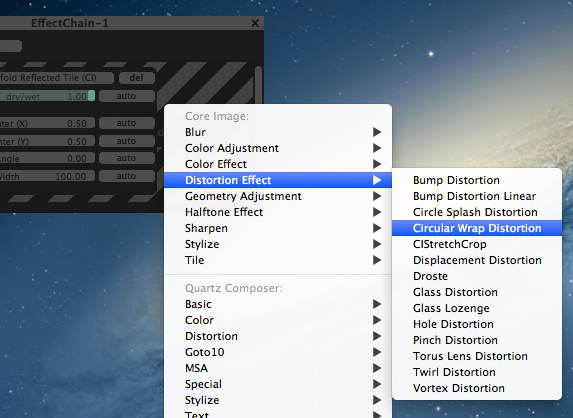In the world of VJ apps, CoGe is an intriguing upstart – a semi-modular design, built around integrating Quartz Composer patches, lets you create customized VJ rigs on the Mac. Hungary has produced both the app and a passionate community of users. It’s time to catch up with this app, including a round of new features available last week in 1.4, work from the visual community, and tutorials on how to get started using it.
What’s New in 1.4
CoGe has been a commercial app for just a year, but a stream of updates has enhanced its functionality. New in 1.4, from the 26th of September, in addition to UI enhancements and improved reliability and stability:
- Enhanced effects: dry/wet faders, and (in the app and your own QC patches) Blends, manual slider values
- Core Image Effect support, for GPU-accelerated filters (using this standard Mac format – some 50 ship with the OS, and third-party modules work, too)
- GPU-accelerated layer groups
- MIDI and OSC sends and assignments – which can be used, for instance, to trigger clips via Ableton Live – plus enhanced OSC support for working with tools like TouchOSC and Lemur
- WebFiles with PHP/HTML support

CoGe is a formidable host for Quartz Composer-based and Apple Core Image effects – now more so, with enhanced routing, blending, control, and GPU-accelerated effect support.
See the full details:
CoGe 1.4 With A Bunch of Enhancements [CoGe blog]
Add this to CoGe’s existing semi-modular functionality:
- Make your own handlers for effects and media sources, all using Quartz Composer (Apple’s visual patching environment, integrated with OS X technologies)
- Input from a variety of media sources (even Flash SWF, animated GIF, HTML), Collada 3D mesh support
- Syphon compatibility for inter-app routing to tools like MadMapper
- Audio analysis and modulation
- MIDI clock input and sync
- Sequencer modules for rhythmic clips
- Layer groups
- RAM disk for optimized playback performance
- LFOs, modulation, and even control via other Quartz Composer patches and effects chaining

CoGe is all about having lots of effects, via Core Image and Quartz Composer – and version 1.4 makes that doubly so.
So, that’s what’s new in the tool. Now let’s actually see how to use it – and what it can do.
Artist Work
None of this is meaningful without seeing actual visual work. So, I asked developer Tamas Nagy to share some of the work people are doing with CoGe, and selected a few of my favorite examples. They give you a sense of what the tool’s artistic capabilities can be.
The B.P.F. crew – with the help of aforementioned Tamas – completed this sophisticated mapping project in Turin using CoGe. Artists: Marco Boni, Antonio Pipolo, Paolo Ferrari.
avs op01 from vargasz abolcs on Vimeo.
Vargasz Abolcs shares his audiovisual work, combining CoGe with Ableton Live via MIDI. It’s a simultaneous live A/V set, recorded live in CoGe.
celloBeatPulse from vargasz abolcs on Vimeo.
celloBeatPulse is another A/V creation by the same artist, produced entirely in CoGe, also recorded in Syphon. The project was performed by Bios and Vargasz at LPM 2011, VisionR 2011 and VisualBerlin 2010. More:
http://www.beeplogger.blogspot.hu/
There’s another, more recent project involving body mapping I hope to look at soon – stay tuned.
Tutorials
For a look inside CoGe and how it works, the tutorials are your best bet.
The full album of tutorials is on Vimeo:
http://vimeo.com/album/1644643
But here are a few of my favorites, in that they convey some of the software’s most compelling functionality:
CoGe 1.3 – New movie playback function from luma beamerz on Vimeo.
CoGe 1.3 – MIDI/OSC Talkback from luma beamerz on Vimeo.
CoGe 1.2 – Layer Groups from luma beamerz on Vimeo.
CoGe 1.0 – Using the Sequencer from luma beamerz on Vimeo.
More on CoGe:
http://www.cogevj.hu/
The tool is Mac-only, US$99 (+VAT).
And if you’re using the software, we’d love to hear from you – and see your work.
